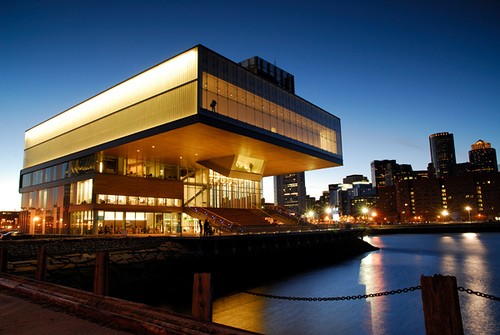Amie Siegel 2010 Winner of ICA Foster Prize
Works With Issue-Oriented Cinematic Imaging
By: Mark Favermann - Dec 16, 2010
Following a recent trend for art institutions and competition juries to now recognize less traditional forms of visual art, Amie Siegel has been named the winner of the 2010 James and Audrey Foster Prize, the Institute of Contemporary Art announced today. This biennial award recognizing a Boston-area artist of exceptional promise carries a $25,000 prize and an opportunity for the finalists to present their work in an exhibition at the ICA. Siegel’s work, along with work by the eight other finalists—Robert de Saint Phalle, Eirik Johnson, Fred H.C. Liang, Rebecca Meyers, Matthew Rich, Daniela Rivera, Evelyn Rydz and Stephen Tourlentes—is on view at the ICA through Jan. 17, 2011.
“We are delighted that Amie Siegel has been named the latest recipient of the award and would like to congratulate all the 2010 finalists, whose work truly demonstrates the strength, vitality and talent of Boston’s art community,” says James Foster, Chairman, President and CEO of Charles River Laboratories. James and Audrey Foster, passionate collectors and supporters of contemporary art, endowed the prize with their $1 million gift to the ICA.
“The Foster Prize creates an exciting opportunity for us to celebrate the work of Boston-area artists and is an integral element of the ICA’s programming,” says Jill Medvedow, Director of the ICA. “I am thrilled to congratulate Amie, whose work combines sophisticated knowledge of cinematic history and technique with a unique vision of relevant, trenchant issues of the day—foreclosure and the fetishization of military culture through fashion and media.”
Amie Siegel (b. 1974, Chicago) works in 16mm and 35mm film, video, photography, sound, and writing, often using the cinematic image as a material means to a conceptual end. For the 2010 James and Audrey Foster Prize exhibition, Siegel created Black Moon, a 20-minute film accompanied by nine prints that show individual frames from her film, each marked by a hole punch. Filmed in an abandoned, middle-class housing development located outside Los Angeles, Black Moon looks to a future that could not imagine a post-apocalyptic American landscape.
The winner was chosen by a jury including New York-based sculptor Chakaia Booker; Dominic Molon, chief curator at the Contemporary Art Museum, St Louis; and Claudia Schmuckli, director of the Blaffer Art Museum at the University of Houston. They spent two days interviewing the nine Foster Prize finalists looking at their entire body of works.
First established in 1999, the James and Audrey Foster Prize (formerly the ICA Artist Prize) is key to the ICA's efforts to nurture and recognize Boston-area artists of exceptional promise. The program creates a significant opportunity for locally-based artists to exhibit their work in a leading contemporary art museum, and offers a financial award of $25,000 to the winner. Recipients of the Foster Prize to date include Ambreen Butt (1999), Laylah Ali (2000), Taylor Davis (2001), Alice Swinden Carter (2002), Douglas R. Weathersby (2003), Kanishka Raja (2004), Kelly Sherman (2006) and Andrew Witkin (2008). Works by Ali, Butt, Davis, and Sherman have entered the ICA Collection, as well as by Rachel Perry Welty, a 2006 prize finalist.
Siegal has an academic's awareness of cinematic symbolism and narrative tools. She references pop culture and film history while speaking to current events and philosophical as well as political positions. Her work is at once cerebral as well as down to earth. Far from formulaic, Amie Siegal explores the experiential and the visceral with the visual and environmental.
It must be in the air. Aural Art and/or more cinematic or video/filmmaking integrated art is a current international trend. Besides Amie Siegal receiving the 2010 Foster Prize, Susan Philipsz, a Scottish born but Berlin-based sound sculptor, was awarded the 2010 Turner Prize of 25,000£. In addition, now being shown at London's prestigious Serpentine Gallery is work by Paris-based artist Philippe Parreno. This is his first exhibit in a public gallery in the UK. Through the cinematic image or the exhibition itself, Parreno explores and manipulates contemporary signs, images and sounds in all of their hallucinatory reality. Within the exhibit, two of the rooms are empty except for sound in one and quiet in another. The third room combines cinematography and sound both natural and man-made.
Profiles of the 2010 Foster Prize finalists
Robert de Saint Phalleis a sculptor who graduated from Cooper Union with his BFA in 2001 and Bard with his MFA in 2007. He is currently Adjunct Professor of Sculpture and New Media at Massachusetts College of Art, Boston. In his artist statement, de Saint Phalle writes, “What concerns me as an artist is the space between what a thing seems to be and what it is.” He uses materials ranging from fiberglass to fluorescent bulbs, and incorporates techniques including CT scans and Rapid Prototyping into his work.
Eirik Johnson is a photographer who received his BFA from the University of Washington in 1997, and his MFA from the San Francisco Art Institute in 2003. He is currently Associate Professor of Photography at Massachusetts College of Art and Design, Boston. His photographs of the American West were featured in a solo exhibition at the Henry Art Gallery at the University of Washington in 2009. Recent projects include large-scale images of the Peruvian Amazon that also have a sound element.
Fred H.C. Liang makes work using sources including traditional Chinese paper cut, Jian Zhi, and Song Dynasty scroll paintings. He received his BFA from the University of Manitoba in Winnipeg in 1989, and his MFA from Yale University School of Art in 1991. In his artist statement, he writes, “During the past decade my work has intertwined such seemingly oppositional perspectives as Eastern and Western philosophy, Taoist poetry, art and science, as well as ephemeral and concrete references to places near and far.”
Rebecca Meyers is a filmmaker who shoots, edits, and finishes on 16mm film. She has a BA from Cornell University, 1997, and a MFA in Film and Video Production from the University of Iowa, 2001. Her most recent films investigate the natural world in relation to cultural and historical representations of nature.
Matthew Rich works with latex paint on cut paper to make paintings that straddle the boundary between two and three dimensions. He received his BA from Brown University in 1998, and his MFA in Painting and Drawing at the School of the Art Institute of Chicago in 2004. His work has been featured in recent solo exhibitions at samson (Boston), devening projects + editions (Chicago) and The Suburban (Oak Park, IL). He is a Lecturer in the Department of Art + Design at Northeastern University.
Daniela Rivera creates paintings on three-dimensional structures and installations. She received her MFA from the School of the Museum of Fine Arts, Boston in 2006, and is currently an Assistant Professor at Wellesley College. In her work, she looks at the function of decorative paintings from the 17th and 18th centuries, in particular, at murals and frescos that performed as what she calls “deceiving visual decorations of indoor spaces,” and at the migration of people and ideas as seen through a cultural lens.
Evelyn Rydz creates intricate and detailed drawings based on her own photographs of objects and places. She received her BFA from Florida State University in 2001, and her MFA from the School of the Museum of Fine Arts, Boston, in 2005. She is currently working on two series of drawings, both related to the Boston coastline. As she describes them, the first depicts items the sea has rejected, and the second creates places where they exist together.
Steve Tourlentes is a photographer who for the past several years has been photographing prisons across the U.S. He received his BA from Knox College, and his MFA from Massachusetts College of Art, where he is currently Visiting Professor of Photography in the Media and Performing Arts Department. He has served as Contributing Editor for Blindspot Magazine since 1999. He is the recipient of, in 2007, an Artadia grant. In his artist statement, he writes, “Prisons exemplify a ritualistic use of time and/or ‘death’ to mediate a facet of complex social interactions and public policy. These temporal sites reflect a boundary of the social compact through their location, population, and social mandate.”




